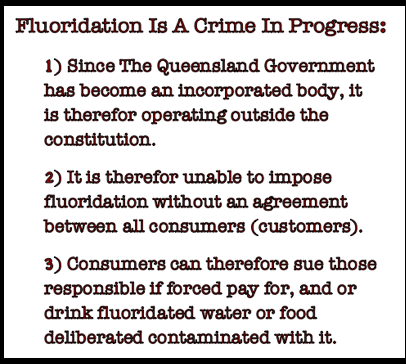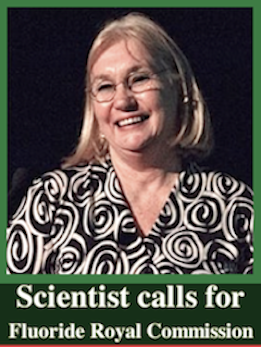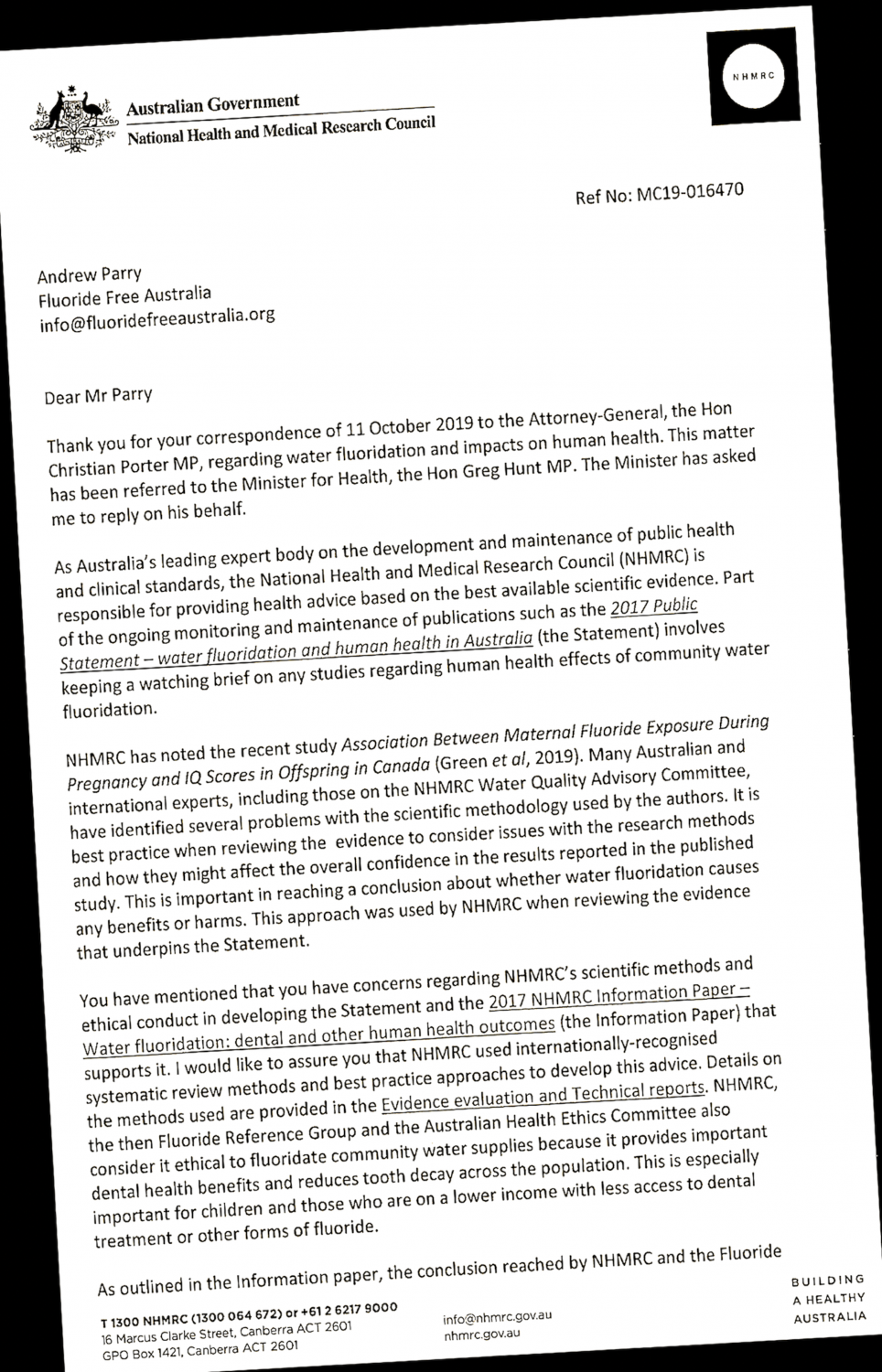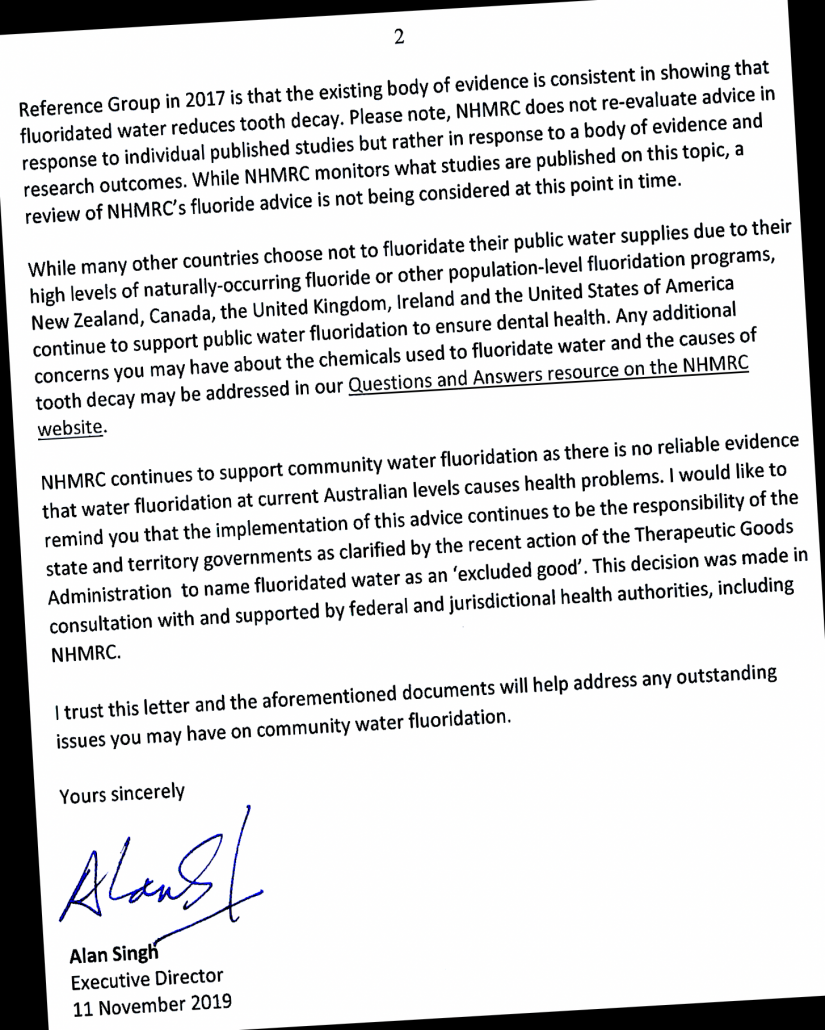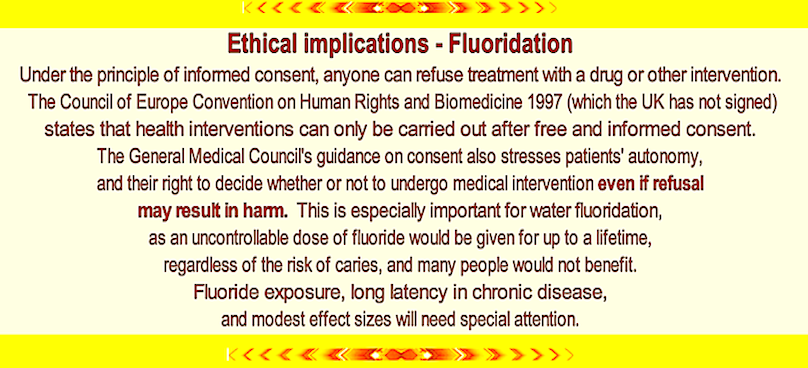HOWEVER ↓ ↓
Court Rules F. IS Medicine
Weeping and wailing and gnashing of teeth:
Legal letter to Elizabeth Koff – Re Water Fluoridation
We want Queenslanders to have, what most countries
on this planet have – no artificial water fluoridation!
Fluorides are so highly toxic that a single truckload of this
industrial waste from the phosphate fertilizer industry,
used to fluoridate public drinking water, is sufficient
to kill the whole Australian populace outright.
Censorship is anathema to us.
Fluosilicic acid treatment of water is repeatedly
misrepresented as being ‘natural’ see below.
The Ten Major Fluorides
↓ ↓ ↓ ↓ ↓

The Queensland Fluoridation of Public Water Supplies Act – requires that:
… a local government shall not be authorised by this Act to add fluoride to a public water supply under its control if at a poll taken pursuant to the part the number of votes against is greater than the number in favour of the addition of fluorine to the public water supply …
While the Act does not appear to require a council to conduct a referendum prior to the introduction of fluoridation to the water supply system; in practice it is considered unlikely and unwise for a council to take such action without first undertaking a ‘poll’ to determine the level of support within the local community.
U.S. FEDERAL COURT
ACTION NO. 17-CV-02162
FOOD AND WATER WATCH, et al. v. U.S. EPA
EXPERT DECLARATION OF PHILIPPE GRANDJEAN, MD, DMSc
PREPARED ON BEHALF OF PLAINTIFFS
20 May 2020
Full Paper ⇒ HERE ⇐ 115 pages
[ We at ‘Fluoridation Queensland’ believe that councils can and should
switch off water fluoridation plants, but should notify its customers.]
Qld. Gov. Policy on Fluoridation – current
→ OPEN LETTER TO THE QUEENSLAND GOVERNMENT ←
The Queensland State Government may be in breach of sections
204 & 240 of the Queensland Criminal Code – 1899,
by deliberately adding toxic heavy metals & poisons, including
fluorides, in any quantity, into public drinking water.
See also ↓
Fluoridation – Breach of Version 1.2 – Sept. 2013 Code of Practice
Queensland – A Corporate Entity
The State of Queensland Australia is
registered with the US Securities and Exchange
Commissions under No. 0001244818 :
On the 15 July 2002, The Corporations (Q) Act 1990 (Q) Reprint No 3 created in
Qld. a Corporate Government. The State of Queensland Australia is registered
with the US Securities and Exchange Commissions
under No. 0001244818.
Queensland is technicality a corporate entity and
therefore OUTSIDE the Australian Constitution.
Fluoridation is Mass Medication,
New Zealand Supreme Court Rules
Freedom of Information Act 1982.
Fluoride and Novichok
WHO extracts – Environmental Health Criteria 227-Fluoride
Water Fluoridation: Risky Business for Council-Michael Lusk
»→ FAN wins second round in court case… ←«
TSCA Fluoride Lawsuit Fully Funded, Thanks to FAN Supporters
HIGHLIGHTS IN NORTH AMERICAN LITIGATION
DURING THE TWENTIETH CENTURY ON
ARTIFICIAL FLUORIDATION OF
PUBLIC WATER SUPPLIES
John Remington Graham
& Pierre-Jean Morin
HERE
STATE OF THE NATIONS – Fluoridation
~ WATER FLUORIDATION IN QUEENSLAND IS ILLEGAL ~
We suspect that any private citizen, company, corporation
(which includes Queensland Government, now registered as a corporation**),
or terrorist, would be expected to face the full force
of the law for such a criminal act as fluoridation.
Note: We the people of Queensland were not consulted, fully informed and
no referendum was held on the matter of water fluoridation.
[ In fact all citizens protests, including ours were ignored. ]
WE WERE NOT CONSULTED ABOUT FLUORIDATION, AND WE ARE
VERY HAPPY TO HAVE IT REMOVED WITHOUT BEING CONSULTED.
XXXIst CONFERENCE ADVANCES IN FLUORIDE RESEARCH –
Letters 1963 + Dr. Robin Warwick 2016
No Fluoridation in Holland -1973
ISRAEL STOPS FLUORIDATION
The $4 billion NIS Class Action ($500 NIS for each Israeli
citizen), accuses “Mekorot” of providing the Israeli
citizens with false information regarding their
drinking water content and causing
environmental damage for
the past 10 years.
A damning critique and analysis of the NHMRC’s 2017
“Sham” review of Water Fluoridation and
an appeal for a Royal Commission Inquiry:
23 Reasons why Australia needs a Royal Commission into the
NHMRC’s fraudulent fluoride review.
by – Merilyn Haines –
-=-=-=-=-=-=-=-=-=-=-=-=-
The NHMRC policy is not based on science
as evidence by the letter below! ↓
THE TGA IS FUNDED BY DRUG COMPANIES.
The Therapeutic Goods Administration is responsible for regulating therapeutic
goods including prescription medicines, vaccines, sunscreens, vitamins
and mineral medical devices, blood and blood products.
However our gardens plants and many weeds and
industrial chemicals are also used for healing,
and they cannot be patented or restricted.
Some say this is the worst pollution in Australia’s history – over 70 sites, but
the Australian media, except ABC TV ’Four Corners’ are ignoring it
↑ WATCH ↑
“The Protected Pollutant”
Fluoride is NOT mentioned by name.
!
We have not finished with this, – many long term legal battles are yet to come.
Hopefully this will bring the dangers fluoridation into more focus. –
But don’t hold your breath …
_______
… In 1957, THE SUPREME COURT OF CANADA RULLED: – [F. Not Legal ]
that this added fluoride is medication for a special health purpose
and the law then did not allow the use of municipal water supply
for this intent and delivery – (Supreme Court of Canada).
To this day, no provincial law–not the Safe Drinking Water Act, Public Health Act or the Fluoridation Act–authorizes the use of public drinking water to deliver any substance meant to treat or prevent disease when consumed. This fact alone calls for an immediate review of PEO’s current policy (or lack thereof) that enables and condones municipal water fluoridation in Ontario on the basis of reports from professional engineers …
Shine Lawyers
has welcomed the Federal Government’s
proposed new range of protections for
Australian corporate whistleblowers.
October 2017
Draft Bill To Increase Whistleblower Protections
Fluoride Lead and Pipes
LET IT BE KNOWN:
Fluoridated water is a ‘Therapeutic Goods’ and also a Medicine
as per the definition of the Therapeutic Goods Act 1989.
The NHMRC, All Australian Health Departments, State and Federal and
the Australian Dental Association claims on fluoridation by definition
bring the practice within the definition of this Act.
Whether fluorides are delivered by needles, tablets or delivered via
the public water supply, it is against the law to administer any medicine
→ without the consent of the patient. – NO EXCEPTIONS –
All Governments, Local, State, Federal [and UN] are hereby advised to
terminate fluoridation immediately, before someone ends up in court…
The full text of the above can be found »→ HERE
7 OCTOBER 2015 Mosaic Fertilizer was fined $2 BILLION
Mosaic Fertilizer, one of the largest sellers of
“fluorosilicic acid” that cities add to
public drinking water [USA].
It is described by EPA a “hazardous waste.”
The chemical used in Australia contains the same contaminants.
‘Mosaic’ updates it’s MSDS giving a warning for children!
No Fluoridation in Holland -1973
Unholy Water
Torah Principles
“… it will be shown that water fluoridation & vaccinations violate the Torah principles of kashrut, pekuach nefesh, and ushmartem es nafshoseichem (taking proper care of one’s health) and therefore ought to be considered as treif and assure…”
False witness is among the six things God hates – King Solomon.
MEMORANDUM TO:
Liesa Cianchino, Chair of Concerned Residents of
Peel – to End Fluoridation
FROM: Nader R. Hasan – DATE: 23 June 2014
You have asked me to provide an opinion on the lawfulness of the Region of Peel’s fluoridation program. In short, if an Ontario resident can properly present the existing scientific and medical evidence to an Ontario court, then there is a reasonable possibility that an Ontario court would declare the Fluoridation Act and municipal fluoridation programs in Ontario to be unconstitutional and thus invalid. – Read on
CITY SUED OVER FLUORIDATION
A copy of the original PRELIMINARY DECREE 1973
is held by us ‘Fluoridation Queensland’
![]()
The TGA, The Drug Industry and Your Health
WHO and ‘Dodgy’ Fluoridation Endorsement
Human Rights, Civil Liberties, and Water Fluoridation.
Credit to:
Douglas Cross, BSc,CBiol,EurProBiol,FSB
Utah questions toxic fluoridation. The state has just come to realize that it is
getting many extra toxins – tramp contaminants – at no extra charge,
along with its monthly medicinal poisonings from fluoride.
Utah is becoming the first state to question the criminally stupid
absurdity of paying chemical companies to dump
toxic waste into its drinking water.
»→ MORE ←«
SUPPRESSION OF CIVIL RIGHTS IN AUSTRALIA REGARDING FLUORIDATION
In 1992, “Americans spent more than $700 million on inhome filters”
and more than $2 billion on bottled water in efforts to
avoid drinking contaminated water.
PACE ENVIRONMENTAL LAW REVIEW
Volume 14, Number 2 Summer 1997
Copyright © 1997 by Pace University School of Law All rights reserved
reprinted here with permission
Fluoridation of Public Water Systems:
Valid Exercise of State Police Power or Constitutional Violation?

»⇒ HERE ⇐«
»→ HERE ←«
[The atrocities committed by Nazi physicians and researchers during World War II
prompted the development of the Nuremberg Code to define the ethics of modern
medical experimentation utilizing human subjects. Since its enunciation,
the Code has been viewed as one of the cornerstones of
modern bioethical thought.]
The Protocol For The Prohibition Of The Use In War
Of Asphyxiating Poisonous Or Other Gases, And
Of Bacteriological Methods Of Warfare.
Was Signed at Geneva: 17 June 1925
See »⇒ Sarin in Syria (fluoridated)
FLUORIDE – THE NEXT ASBESTOS
⇓ The Longest Court Case in Scottish History ⇓
” NO FLUORIDE — ‘SCOTLAND THE BRAVE “
→ When Gerry Adams And Ian Paisley Worked Together ←
Fluoridation is an act of violence
committed on the trusting public!
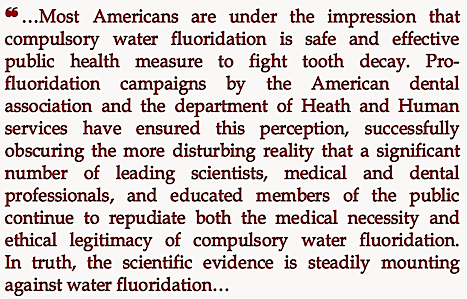
…Justice Yetka believed that the state’s intrusion was
neither reasonable nor the least intrusive method
to provide the alleged public health benefit….
Links to Rita’s site → HERE
More → HERE
FDA’s Official Definition of → “Safe and Effective”
“Like all nostrums, fluoridation will soon pass away.
In 50 years from now it will be known as the
greatest hoax in medical history.”
Judge R.C. Tarter. – [ The 50 years are nearly up! ]
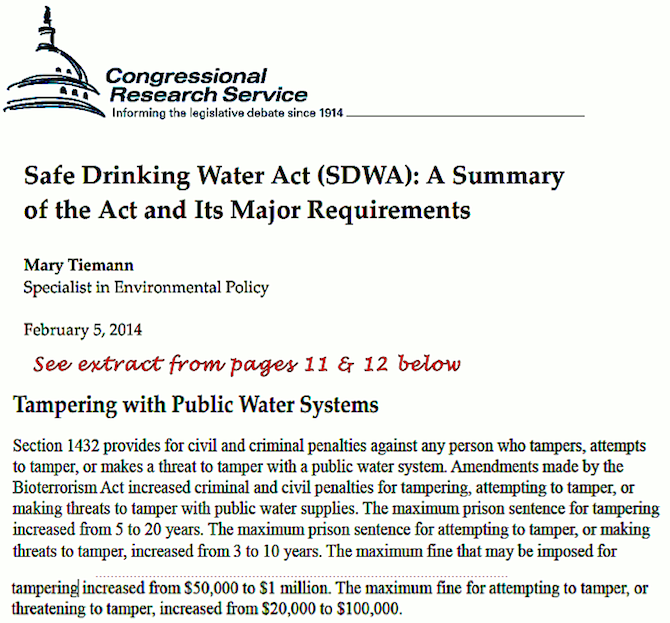
Full text »→ HERE
“When you see that in order to produce, you need to obtain permission from men who produce nothing and when you see that money is flowing to those who deal, not in goods, but in favours and when you see that these men get richer by graft and by their pull – not by their work. When your laws don’t protect you against them, but protect them against you and when you see corruption being rewarded and honesty becoming a self-sacrifice, you may now know that your society is doomed.”
– Ayn Rand
FLUORIDATION HAS A CULT FOLLOWING.
Fluoridation has all the characteristics of the mystery cults and religions,
which have controlled man and the destinations of nations since
primitive times. Thriving on the gullibility of human species
by the propaganda of fear. Fluoride is the new God,
the saviour of all teeth, not to partake of this
holy water is to be forever damned
by this very profitable lie.
The Queensland State Government may be in breach of sections of:
** THE CRIMINAL CODE 1899 – SECT 87
Queensland – A Corporate Entity –
This is NOT about fluoride but has legal
implication for fluoridation:
»→ Mass Action of Liability ←«
Fluoridation Equipment Failures
There have been more pay-outs for
fluoride damage than for any other pollutant !
– Mostly “Out-of-Court” settlements.
Industrial Fluoride Pollution YouTube
$ $ $ $ $ $ $ $ $ $ $ $ $ $

Hydrofluoric Acid aka Hydrogen Fluoride
Dr. Richard Sauerheber & James Robert Deal
Hydrogen Fluoride more information → HERE
CONFERENCE ADVANCES IN FLUORIDE RESEARCH
Fluoride and 1080 – Sodium fluoroacetate
“…Part of this [his] work has included 6 investigations
of actual and alleged chemical weapons use…”
Fluoride and Novichok
—————
TGA POISONS STANDARD 2009 (fluoride)
————————–
The FDA Issued Warning Letter to Pharmaceutical Company on Fluoride…
———————————
Changing Times For Products
——————————————
Famous Last Words on “SECRECY”
The Independence of Cyberspace
Or very wise!



